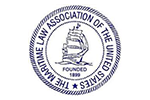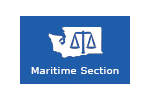Wrongful Death Attorneys
Enhanced Injury Doctrine Adopted into the General Maritime Law
By John Merriam and Gordon Webb
“Bringing a product liability action with no product is difficult.” A lawyer with more experience than me explained why he’d previously declined a case I accepted. His words proved prophetic.
On April 25, 1998 former Seahawk football player Carl Van Valkenberg was master of the fishing vessel F/V Evanick. The 50-foot salmon seiner motored toward the herring fishery off Togiak, Alaska. At 0700 hours that morning Carl and his crew of three were in the southern stretch of Shelikof Strait, between the Alaska Peninsula and Kodiak Island. The seas were 10-18 feet with winds approaching gale force.
Sometime during the next hour the F/V Evanick capsized. The bodies of Carl Van Valkenberg and his crew have never been found.
Coast Guard divers arrived several hours later to examine the capsized Evanick. They were unable to enter the vessel to look for survivors or bodies because the seas were so rough. In the words of one, the Evanick was “a bucking bronco”. The divers did note that the inflatable liferaft was still strapped in its cradle atop the wheelhouse. The straps were secured by a Hammar hydrostatic release unit (HRU) that had not activated.
The first signal from the F/V Evanick’s EPIRB (Emergency Position Indicator Radio Beacon) was not received until 11:30 that morning. It is estimated that the capsizing occurred approximately four hours before then based upon the amount of time needed by another boat, once near the Evanick, to return to the scene. The ERIRB is thought to have functioned as designed but, due to satellite positioning, the Coast Guard believed that the first “hit” was not received for some time. The EPIRB had been secured to the Evanick with a separate, identical Hammar HRU slightly lower than the liferaft, when the vessel floated upright. That meant that, when capsized, the HRU for the EPIRB was shallower than the HRU for the liferaft. The HRU for the EPIRB activated; the HRU for the liferaft did not.
The Coast Guard concluded that the F/V Evanick likely broached (swung broadside to the waves in a trough) in a following sea. The broach and capsize were thought to have occurred very rapidly and without warning. The divers found all four survival suits still in their bins on the flying bridge.
The divers variously estimated the capsized depth of the HRU for the Evanick’s liferaft at 10 to 15 feet. A Coast Guard Investigating Officer put the depth at 13 feet. Product literature from Hammar advertises activation depth for the HRU at 1.5 to 4.0 meters (less than 5 feet to 13 feet one-and-one-half inches). Those depths were given based upon a flat sea. On April 25, 1998, one of the divers estimated the capsized Evanick surged 10 feet up-and-down in a very turbulent sea.
Two days after she capsized the Evanick was declared a hazard to navigation and scuttled with .50 caliber machine gun fire from a Coast Guard cutter. She now rests at 100 fathoms (600 feet) in the Shelikof Strait. The liferaft never surfaced. The three divers later received awards for heroism.
More than two years later the Coast Guard re-opened its investigation into the loss of the Evanick at the request of Carl’s widow, Leslie Van Valkenberg. The second Investigating Officer recommended the manufacturer issue warnings that free-floating rafts might be more appropriate for shallow-draft vessels like the Evanick because of the danger that liferafts on such vessels might not reach maximum activation depth following a capsize. Coast Guard Headquarters overruled that recommendation due, the writers suspect, to political pressure from the industry.
When Carl drowned his wife was pregnant with their only child. Carli Van Valkenberg was born the following October and has never seen her father. A one million dollar Protection & Indemnity insurance policy was exhausted settling claims from survivors of the three crewmembers, with nothing left for Carli and Leslie. Because Carl was master of the F/V Evanick when she capsized, P&I club lawyers decided that Carl’s heirs had little chance of recovery in a Jones Act claim for negligence.
Leslie Van Valkenberg retained counsel just before expiration of the three-year limit. These practitioners knew the case was an uphill battle but agreed to pursue it because we were dismayed that the Coast Guard and the HRU manufacturer were doing nothing to prevent further death in the seine fleet.
Suit was filed in the Western District of Washington and assigned to Judge Rothstein. Plaintiffs’ theory of liability was simple: If the HRU exceeded maximum activation depth and did not deploy, it was defective. If the HRU was not at activation depth after the capsizing, it was not appropriate for a shallow-draft vessel like the F/V Evanick, and the manufacturer should have provided warnings and mounting instructions to customers. If the Hammar HRU was designed to activate only when vessels sank, but not when they capsized, customers should have been likewise warned. No warnings were given. No mounting instructions accompanied the Hammar HRU.
The defendants focused primarily on the negligence of Carl Van Valkenberg and took the position that he was the sole cause for the deaths of all aboard the Evanick because he brought the boat into the sea conditions where she capsized. Plaintiffs moved for an order of partial summary judgment that Carl could not be found contributorily negligent for causing an emergency—in a product liability claim— when the product involved was designed for use only in an emergency situation. Plaintiffs found no cases on point and argued rescue cases by analogy. That is, “a plaintiff’s negligence, which may have precipitated the rescue effort, is not relevant to the comparative fault calculation.” Hurd v. United States, 2001 AMC 1555, 1590 (D. S.C. 2001).
Judge Rothstein granted the motion, ruling that any contributory negligence on the part of Carl Van Valkenberg was relevant to the case only if it occurred after the Evanick capsized.
Defendants moved for reconsideration and Judge Rothstein reversed herself. The District Court ruled that all of Carl’s conduct preceding his death was relevant and admissible into evidence.
Convinced that Judge Rothstein’s initial ruling was the correct one, counsel for the plaintiffs dressed their contributory negligence motion up in different clothes and filed another motion for partial summary judgment. This time, plaintiffs prayed to get past summary judgment of dismissal and argue to a jury that the HRU product was defective, even though there was no product to examine for defect. In other words, this particular product was lost at sea—along with all witnesses—as a result of product malfunction. Plaintiffs wanted the burden of proof shifted to defendants, to prove that Carl and his crew could not have survived even if the HRU had functioned as designed and the liferaft deployed.
Counsel for the plaintiffs had little experience with product liability actions and signed up for a WSTLA Case Evaluation Clinic. At the Clinic, we got slapped around and told to drop our ‘jury issue’ motion. Stating that Judge Rothstein’s first ruling on comparative fault was the correct one, Dexter Washburn and the other two lawyers on the panel told these practitioners to draft, instead, a motion to apply the enhanced injury—or “crashworthiness”—doctrine to the facts of this case.
Counsel for the plaintiffs withdrew their motion, before decision, about a ‘jury issue’ and the burden of proof. In substitute, we filed a motion to have the enhanced injury doctrine applied to this case. Unfortunately, there was no controlling precedent to support the motion.
The enhanced injury or ‘crashworthiness’ doctrine evolved from automobile cases 30-40 years ago. Alternatively called the “secondary impact theory”, this doctrine is generally traced to Larsen v. General Motors, 391 F.2d 495 (8th Cir. 1968). Contra, Evans v. General Motors, 359 F.2d 822 (7th Cir. 1966), cert. denied, 385 U.S. 836. Washington adopted the enhanced injury doctrine in 1974—for state courts. Baumgartner v. American Motors, 83 Wn.2d 751.
A manufacturer is liable for injuries or harm proximately caused by its negligence or fault where the defect or design was not a cause of the injury-producing event, but rather was a proximate cause of the injuries or harm. In such cases, the manufacturer is liable for injuries or harm proximately caused by the defective design, over and above the damages that would have occurred if its product had been reasonably safe.
Couch v. Mine Safety Appliances, 107 Wn.2d 232, 242-43 (1986) (en banc).
Other than state court cases in Washington, the closest plaintiffs could come to persuasive authority was from a state court in Florida applying maritime law. That court concluded the “crashworthiness” doctrine should apply to a pleasure boat accident. Rubin v. Brutus Corp., 1988 AMC 416 (Fla. App. 1986).
Judge Rothstein re-characterized plaintiffs’ motion as one requesting that they be able to pursue a particular legal theory, if they could prove that product defect caused Carl’s death.
Despite plaintiffs’ sparse support for their request that this court adopt a novel theory of recovery under maritime law, the court is persuaded that the enhanced injury doctrine is applicable under maritime law. A district court deciding a case under maritime law may refer to state law when there is no rule recognized by the general maritime law on an issue, and the matter does not require national uniformity.
Van Valkenberg v. Puget Sound Inflatables et al., 2002 AMC 2673, 2674 (W.D. Wash. 2002).
However, Judge Rothstein included deadly dictum hinting that, while plaintiffs may have won this battle, they would likely lose the war—and be unable to sustain their burden of proof on the proximate cause of Carl’s demise:
By ruling that the enhanced injury doctrine might conceivably be applicable in a maritime injury case, the court does not intend to imply that it would be appropriate in this case. Defendants raise serious questions as to whether or not plaintiffs will be able to present proof that Van Valkenberg’s death was due to a defect in the life raft (sic). The court is mindful of these concerns, but this is not the proper motion for that argument.
2002 AMC at 2675 (emphasis in the original).
Defendants took the hint and quickly moved for summary judgment. They requested the case be dismissed because plaintiffs were only speculating that Carl and his crew could have survived the capsizing even if the liferaft had deployed.
Counsel for the plaintiffs wanted to argue that public policy demanded, due to the nature of the product in this product liability action, that the burden of proof should shift to the defendants to show that Carl would not have survived the capsizing even if the liferaft had deployed. Because the case involved a product designed for use only in an emergency, product failure meant that all the witnesses and the product itself were unavailable—resting in Davy Jones’ locker. Requiring the plaintiffs to sustain the burden of proof in this situation would be to give the manufacturer of hydrostatic releases virtual immunity from suit. Because no one knew for sure what happened after the F/V Evanick capsized, whoever had the burden of proof would lose the motion for summary judgment, and likely the case as well.
At minimum, plaintiffs wanted to argue to a jury that the failure of the hydrostatic release to activate cost Carl a chance to survive. The undersigned found no maritime cases incorporating the ‘loss of a chance’ doctrine. Once again, the state courts of Washington were ahead of their federal counterparts and had adopted the ‘loss of a chance’ doctrine, albeit in a different context. Herskovitz v. Group Health, 99 Wn.2d 609 (1983).
It was against this backdrop that mediation occurred. Defendants’ motion for summary judgment was pending but plaintiffs had yet to respond. Judge Rothstein’s dictum, supra, meant that plaintiffs would likely lose before trial and their only prospect of salvation, uncertain at best, was in the Ninth Circuit. The plaintiffs had no stomach for a two-year appeal. The case settled for $125,000. The mediator was John Cooper at Washington Arbitration and Mediation Services. Shane Carew was settlement guardian ad litem for Carli.
From a strict financial perspective, this case accomplished little more than create an annuity for Carli Van Valkenberg’s college education, and a modest recovery for Leslie. But some other good came out of it:
First, the enhanced injury doctrine now has persuasive authority for application to all maritime cases in federal courts.
Second, notice has now been given to the manufacturer that the sale of hydrostatic release units—at present levels for activation depth—may not be appropriate for shallow-draft vessels.
Carl did not die in vain.
John Merriam and Gordon Webb represented plaintiffs. John Hayes and Ken Roessler of Forsberg & Umlauf represented defendants.













